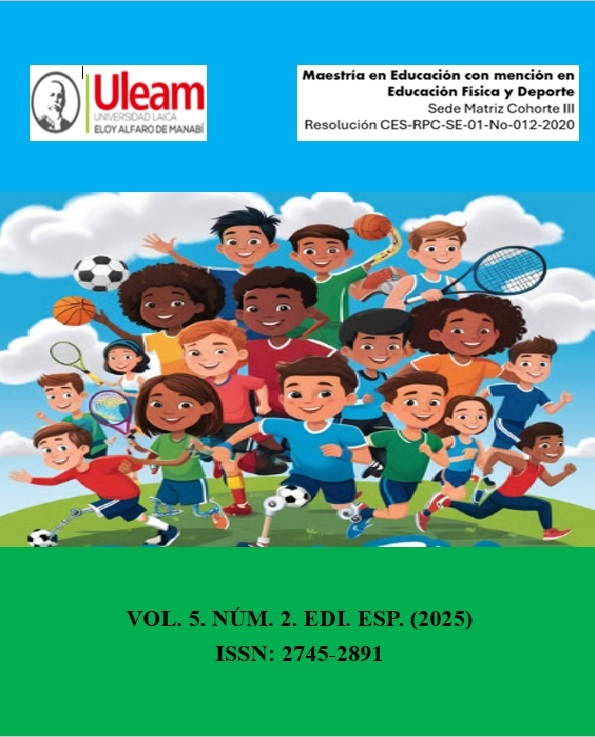Physical activity program to reduce sedentary lifestyle in higher education students
Abstract
Sedentary behavior constitutes a pathology of significant medical concern worldwide, particularly affecting the Ecuadorian population, with adverse effects on the comprehensive health of children and adolescents. The objective of this study addresses the need to reduce the rate of sedentary behavior in the studied population, based on the benefits and effects of physical activity on human holistic health, a topic that aligns with the institutional research line: 'physical culture and human development' of Laica Eloy Alfaro University of Manabí. A cross-sectional, explanatory, and pre-experimental study design was implemented, using a sample of 68 students from the aforementioned academic institution, who underwent an organized physical activity program for 20 weeks, incorporating the curricular content of Physical Education into various class sessions. The criteria employed were based on the consistent application of the International Physical Activity Questionnaire (IPAQ) and a physical fitness test, which yielded concrete results supporting the rejection of the null hypothesis. Among the achieved results, a change in the lifestyle of 68% of the participants was noted. As a conclusive aspect, an increase in the conditional abilities of strength and endurance was observed in the subjects, with a positive correlation as expressed by the data, which corroborates the relevance of the program introduced in the study.
Downloads
References
Arocha Rodulfo, J. L, (2019). Clínica e investigación en arteriosclerosis, 31(5). https://www.elsevier.es/es-revista-clinica-e-investigacion-arteriosclerosis-15-pdf-S0214916819300543
Balestrini (2006). Como se elabora el proyecto de investigación. Consultores Asociados. Caracas.
Campo, A., Campo, E., Coba, J. y Acevedo, A. (2020). Estrategias para la enseñanza de la educación física en busca de la calidad educativa. Revista Científica de FAREM-Estelí, 9(33), 23-34. https://lamjol.info/index.php/FAREM/article/view/9606/10990
Craig, C. L., Marshall, A. L., Sjöström, M., Bauman, A. E., Booth, M. L., Ainsworth, B. E., ... & Oja, P. (2003). International Physical Activity Questionnaire: 12-Country Reliability and Validity. Medicine & Science in Sports & Exercise, 35(8), 1381-1395.
Creswell, J. W. (2014). Research Design: Qualitative, Quantitative, and Mixed Methods Approaches (4th ed.). SAGE Publications.
Cedeño, J., & Loor, K. (2022). Actividad física en adolescentes escolares y su impacto en la salud integral. Revista Ecuatoriana de Ciencias Aplicadas, 10(1), 43–58.
Del Castillo, L. A. E., Hernández, N. C., Luján, R. C., & Olivares, L. A. F. (2021). Physical capacities and their relationship with physical activity and body composition in adults. Retos, 41, 674–683. https://doi.org/10.47197/RETOS.V41I0.83067
Diesra Gamboa, A. C., & Albornoz Ravelo, R. S. (2021). Relación entre la actividad física y rendimiento académico en los estudiantes de la escuela profesional de enfermería de la Universidad Peruana Unión, 2018.
Etikan, I., Musa, S. A., & Alkassim, R. S. (2016). Comparison of Convenience Sampling and Purposive Sampling. American Journal of Theoretical and Applied Statistics, 5(1), 1-4.
Ferrando, M., Alvira, F., Alonso, L. y Escobar, M. (2003). La encuesta. El análisis de la realidad social: métodos y técnicas de investigación. Reis. Revista Española de Investigaciones Sociológicas, (154), 165-169. https://www.redalyc.org/pdf/997/99746727010.pdf
Guerra, M., & Arboleda, L. (2023). Sedentarismo y salud mental en adolescentes: revisión sistemática. Salud y Movimiento, 15(2), 67–78.
González, A. (2018). Evaluación del y para el aprendizaje: instrumentos y estrategias. Universidad Nacional Autónoma de México. https://books.google.com.ec/books?id=SYXZDwAAQBAJ&lpg=PT8&ots=Xum-SmxTF5&dq=estrategias%20para%20el%20aprendizaje&lr&hl=es&pg=PT36#v=onepage&q=estrategias%20para%20el%20aprendizaje&f=false
Hernández, R., Fernández, C., & Baptista, P. (2014). Metodología de la Investigación (6th ed.). McGraw-Hill.
Jim Alex, G. C., Yadira, C. L., Yuliet, Q. D., Osmaida, A. H., & Roberto, C. A. (2024). Relación entre sedentarismo y Diabetes Mellitus tipo 2. In TunaSalud 2024.
Kraemer, W. J., & Ratamess, N. A. (2004). Physiology of Resistance Exercise. Comprehensive Physiology, 1(4), 1-43.
López-Torres, M., Ramírez, D., & Báez, C. (2023). Intervención escolar para disminuir el sedentarismo en adolescentes. Revista Iberoamericana de Educación Física, 14(1), 112–123.
Martínez-Gómez, D., Díaz-González, B., & Ruiz-Ariza, A. (2022). Actividad física y sedentarismo en estudiantes: implicaciones para la salud. Revista Española de Educación Física y Deportes, 437, 55–66.
Molina, M. & Zamora, M. (2024) Hábitos Alimentarios, Actividad Física y Salud en la Población Adulta de la Parroquia Ayacucho, Santa Ana-Ecuador. Proyecto de Investigación en opción al título de Licenciado en Actividad Física y Deporte. Uleam.
Pedemonte, C. (2024). La actividad física y el sedentarismo en los ex alumnos de la promoción 2008 de la IEPGPE. Tte. Crl. Alfredo Bonifaz Fonseca, año 2021. [Tesis de pregrado, Universidad Nacional Mayor de San Marcos, Facultad de Educación, Escuela Profesional de Educación Física]. Repositorio institucional Cybertesis UNMSM.
Rivera-Ferreira, M., Contreras, P., & Gálvez, A. (2023). Escuelas activas: una estrategia para combatir el sedentarismo juvenil. Educación y Movimiento, 11(3), 89–105.
Romero-Blanco, C., Párraga-Montilla, J., & Torres-Luque, G. (2022). El efecto de la actividad física escolar sobre el bienestar emocional en adolescentes. Revista de Psicología del Deporte, 31(2), 52–60.
Villacrés, D., & Cabrera, M. (2024). Estrategias pedagógicas para la promoción de la salud desde la educación física. Revista Ciencia y Educación, 9(1), 24–36.
Copyright (c) 2025 Jairo Pesantes Delgado,Carlos Rafael Núñez Peña

This work is licensed under a Creative Commons Attribution-NonCommercial-NoDerivatives 4.0 International License.






